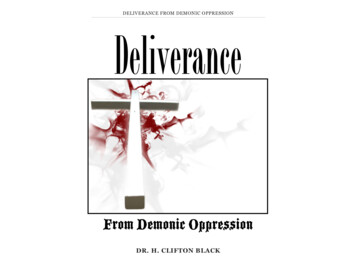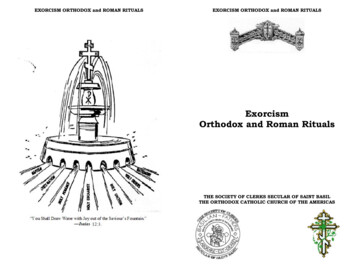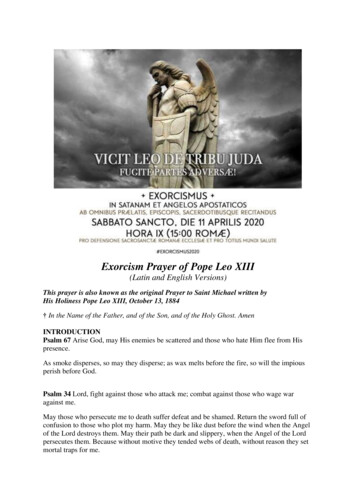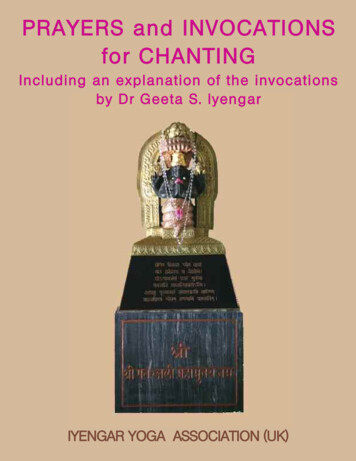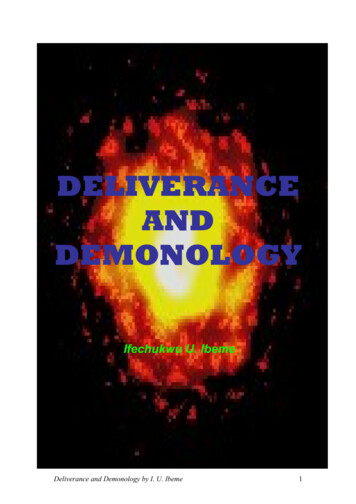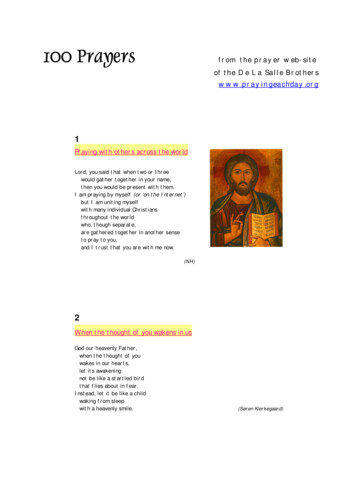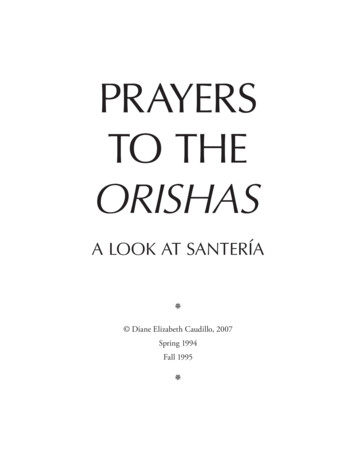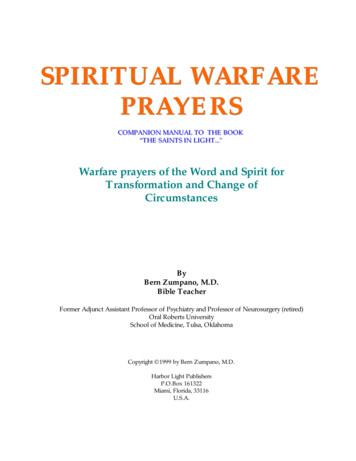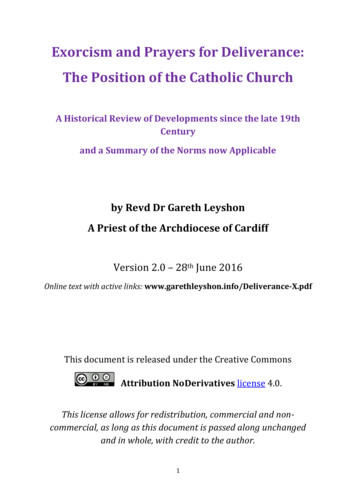
Transcription
Exorcism and Prayers for Deliverance:The Position of the Catholic ChurchA Historical Review of Developments since the late 19thCenturyand a Summary of the Norms now Applicableby Revd Dr Gareth LeyshonA Priest of the Archdiocese of CardiffVersion 2.0 – 28th June 2016Online text with active links: www.garethleyshon.info/Deliverance-X.pdfThis document is released under the Creative CommonsAttribution NoDerivatives license 4.0.This license allows for redistribution, commercial and noncommercial, as long as this document is passed along unchangedand in whole, with credit to the author.1
AbstractThe Catholic Church has carefully defined and restricted the ministry of exorcising the possessedfor many centuries. There is also an ancient tradition of those not ordained priest pronouncingminor exorcisms over adults and children preparing for baptism. Yet the tradition and teachingdocuments of the Church barely acknowledge the possibility of an evil spirit afflicting a personin a manner which falls short of the criteria for possession.In the absence of authoritative Church guidance, and following the example of PentecostalChurches, there has been unrestricted experimentation by Catholics, particularly within thevarious expressions of Catholic Charismatic Renewal from 1967 to the present day, in the‘ministry of deliverance’ which seeks to bring relief to those afflicted by demonic spirits.This document seeks to achieve three things:1) An exhaustive review of all official pronouncements by the Magisteriumconcerning minor exorcism, major exorcism, and deliverance, from the start ofthe 20th Century to the present day.2) A summary of the norms currently applicable to the ministry of deliverance,where these are explicitly stated or can be reasonably inferred from thedocuments identified above.3) A brief survey of key authors giving pastoral guidance or resources for prayer inthe light of what is established above. The key authors are: Cardinal Suenens;Bishop Julian Porteous; Revd Gabriele Amorth; the ICCRS doctrinal commission.IndexAbstract. 2Index . 2Purpose and Definitions. 4Kinds of Demonic Influence . 4Kinds of Ministry . 5A Review of Formal Church Documents. 61)The Status Quo in 1913 . 62)The 1917 Code of Canon Law . 63)The Pre-Vatican II Roman Ritual. 74)The Suppression of the Minor Order of Exorcist . 85)Minor Exorcism before the Baptism of Infants . 86)Minor Exorcisms before Baptism for Adults . 92
7)The CDF Study on Demonology . 108)The 1983 Code of Canon Law . 119)Cardinal Ratzinger’s Letter to Bishops in 1985 . 1110)The Catechism of the Catholic Church . 1111)The 1999 Rite of Exorcism. 1212)The Instruction on Prayers for Healing . 1413)Summorum Pontificum . 14The Rules which Currently Apply . 15Major Exorcisms . 15Minor Exorcisms . 15Sacramentals. 15Places and Things . 15Prayer in Private . 16Implications for Deliverance Ministry . 17The Ordinary Form. 17The Extraordinary Form . 17Minor Exorcisms . 17Exorcisms, not otherwise specified . 18Lay-led activities . 18Sources of Pastoral Guidance. 20Cardinal Suenens – Renewal and the Powers of Darkness . 20Bishop Julian Porteous – The Manual of Minor Exorcisms . 21Revd Gabriele Amorth – An Exorcist: More Stories . 23ICCRS Guidelines on Healing . 24About the Author . 253
Purpose and DefinitionsThe existence of Satan (“the Devil”) and other malevolent spirits (demons, “fallen angels”) is anintegral part of the teaching of the Catholic Church: paragraph 391 (LT IT SP) of the Catechismquotes the teaching of the Fourth Lateran Council in this regard.This document is written as a review and summary of the official teachings of the CatholicChurch on dealing with these spirits.In order to write consistently and clearly, we must first define certain technical terms. Theinternational nature of the Catholic Church complicates this. Some formal teaching documentsare issued in Latin. Often Italian is used, since the central administration of the Catholic Churchis in Rome. I am writing for the English-speaking world, with the possibility that some of thiswork may be translated into Spanish. For this reason, whenever I quote official churchdocuments, I will give a main reference to English, where available, but also reference to Latin,Italian and Spanish versions of texts by applying hyperlinks as exemplified above: (LT IT SP)One particular translation issue must be kept clearly in mind: the term obsession used byEnglish-speaking practitioners does not correspond to the Latin obsessis (Italian ossessa,Spanish obsesa) which is normally rendered into English as possessed.Kinds of Demonic InfluenceEnglish-speaking practitioners generally use the four following terms to refer to the influence ofevil spirits:Oppression – demonic influence which seems to come from outside a person, causingheaviness, weariness or discouragement. Oppressive spirits may be acquired through exposureto a heavy presence of evil: e.g. by participating in deliverance ministry (defined below), bybeing in a place where occult activities are taking place, by being placed under a curse, bycoming into contact with items of witchcraft. Oppressive spirits may be dispelled by a simplecommand to leave in the name of Jesus.Obsession – demonic influence which seems to reside inside a person, usually afflicting acertain area of a person’s life in the form of strong habitual temptations. A person may openoneself to such influnce by deliberately seeking the presence or power of evil spirits throughwitchcraft, Satanism, or fortune-telling (ouija, tarot etc.); demonic obsession may also occurthrough other grave sins which are not explicitly associated with the occult, e.g. sexual activityby consecrated or ordained persons pledged to celibacy. The obsessing spirit usually needs tobe identified by name and cast out (i.e. commanded to leave) or bound (i.e. forbidden fromexerting any further influence).Possession is very rare, and only occurs when human beings wilfully hand over completecontrol of their life to Satan, by expressly doing so or by embracing grave sin. Formal exorcism,sanctioned by the diocesan bishop, is always required in such cases.Infestation is used to refer to the influence of evil spirits over objects, animals, houses or places.These can become infested by exposure to occult activity or by a deliberate curse being directedtowards them.Demonization may be used as a general term covering all the above situations.4
Kinds of MinistryThe Church’s rites of Baptism for Adults and Children include prayers called minor exorcisms,which are used during or before the ceremony of Baptism itself. These are automaticallyperformed as part of the preparation for Christian baptism. There is no need for evidence thatthe catechumen (person preparing for baptism) is being specially afflicted by demons.The rite which seeks to liberate a person who is possessed is called major exorcism. In popularculture, unqualified reference to an “exorcism” invariably means this kind.Among English-speaking practitioners, the term deliverance, a generic term for freeingsomeone from the influence of a demon, is applied specifically to cases of obsession andoppression of persons, and infestation of places.The usual use of words is therefore one in which (major) exorcism is a specific ministry topersons who are possessed; deliverance is ministry to persons who may be oppressed orobsessed by evil spirits, or over places and things which may be infested. Contrary to commonEnglish usage, being “obsessed by evil spirits” here DOES NOT mean “narrowly and intentlyfocussed on thinking about evil spirits”.When major exorcisms or other acts of deliverance are being carried out, two kinds of spokenformulae are used:A deprecative formula is a prayer which petitions God to liberate a person from theinfluence of an evil spirit.An imperative formula is a command addressed directly to an evil spirit.An important reason to make this distinction is found in Scripture itself – see the Epistleof Jude, verse 9.Any formal exorcism is normally authorised by the Diocesan Bishop. Legal church documents,however, often refer to the Ordinary. Under most circumstances, this term refers to thediocesan bishop or his deputy (vicar general), but for members of certain religious orders orother special groups in the church (e.g. personal prelatures), and in territories where there is nodiocesan bishop, it may indicate another church official. Most readers of this document cansafely assume that the Ordinary under whose authority they fall is their local Diocesan Bishop.5
A Review of Formal Church Documents1) The Status Quo in 1913We begin this review in the early 20th Century. At that time, and following a custom dating backto the early centuries of the Church, men preparing for priesthood were successively ordainedto minor orders called porter, lector, exorcist and acolyte and then the major orders ofsubdeacon and deacon before finally being ordained priest. Those who had received the minororder of “exorcist” had authority to pray the minor exorcisms over catechumens preparing forbaptism. Ministry to those believed to be possessed, however, was not entrusted to theseexorcists, but only to priests, who followed the rite of major exorcism set down in the RomanRitual. (Usually, depending on local rules, the priest would need the local Bishop’s expresspermission.) The word “exorcism” was applied to three practices in the Church: not only theminor and major exorcisms just identified, but also to certain blessings over oil, salt and water.All the hyperlinks in the paragraph above are to text from the 1913 Catholic Encyclopaedia whichoffers an excellent
of Exorcism ó but in Latin as Ritus Exorcizandi Obsessos a Deamonio (Rite of Exorcising those Posessed by Demons), is only to be conducted by a priest who has been expressly instructed to do so by the Ordinary (local Bishop or equivalent).File Size: 870KBPage Count: 25
